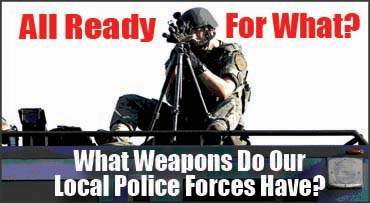Serving the Towns of Wawarsing, Crawford, Mamakating, Rochester and Shawangunk, and everything in between | |||
| |||
|
All Ready For What?
What Weapons Do Our Local Police Forces Have?
REGIONAL – An odd and unsettling side effect of America's plunge into various wars on drugs, Iraq, Terror, and Afghanistan has been the visible militarization of many American police forces. This became starkly visible when the police in a small Missouri city rolled out an armored personnel carrier, sporting a .50 caliber machine gun on top pointed at a community of demonstrators.
Somewhere along the way SWAT teams proliferated across parts of the country, and with them an attitude that policing is now more paramilitary than community-oriented. Police SWAT teams are now deployed about 50,000 times every year, not quite fitting into the original Special Weapons And Tactics concept, which was of an elite force reserved for truly dangerous situations such as hostage situations, armed bank robberies, or large scale disturbances. Was a new norm in place? Not here, our reporting shows. "We have no weapons from the military," says Dominick Blasko, chief of the Town of Crawford Police. "We do have a Humvee, which we got for emergencies, like flooding. It could get into places that nothing else could. And we had flooding problems a few years back with the tropical storms." Chief Frank Petrone, of Shawangunk Police, says much the same: "We don't buy anything from the military." Perry Soule, chief of Rosendale Police, has more prosaic items on his wish list. "I plan on getting office equipment if I can, but we're not looking for weapons," he said. "I'm always looking for desk chairs, the hardest thing to budget for." Chief Phil Mattracion of the Ellenville PD points out some of the reasoning for our local police forces' lack of interest in machine guns. "We don't need those. We're not complacent, we're not defenseless, either. But every Police Officer has to think carefully about not just what they're shooting at, if they have to shoot, but also about what's behind the target," he explains. "In other words, we have to look at the forest behind the trees." As in, is there a house there? A school, a bus? Mattracion notes that "Ulster County has the Emergency Response Team from the Sheriff's office; that's a specialized unit, with the appropriate training, that comes in for infrequent things. Like we had a shooter seven years ago in the streets of Ellenville. Over the years we've called on them a couple of times." Chief Soule agrees. "I rely on the sheriff and state police for specialist units when we need them. That could be everyday support depending on how the day is going, but usually isn't," he said. "One of the unique things about Ulster County is that we all get along well as one big law enforcement family. So if anyone needs extra help we can call on the sheriff, the state police or our neighbors." Only in the City of Kingston is there a SWAT team and armored vehicles bought from the military, all part of what Chief Egidio Tinti says is part and parcel with the policing of a city he feels is the equivalent of Yonkers. "We've used all this less than a half dozen times this year, for executing warrants mainly," he said. "It's no different than having a fire extinguisher in the corner. Like so many good law enforcement officers, I like to say we pray for peace but prepare for war." Other than desks and chairs, are there items that our smaller town chiefs could be interested in? Chief Soule, of Rosendale, noted that "the Humvee makes sense, because out here in the country we do have some of the hardest access issues in an emergency. And if you can get it from the service, then that's good for the budget. One thing we could use would be night vision binoculars; they would be a help when you're searching for someone in the dark, whether it's a two year old or a ninety-two year old." First Sergeant Allen Rowe, team commander of the Ulster County Emergency Response Team, makes a very crucial point. "This requires a higher level of training for members of the team, so there's a minimum two week basic SWAT school. Then we train twice a month during the year, plus there's a one week training once a year, along with going to SWAT seminars. We also send the team to three-day multi-training seminars." Sergeant Rowe adds, "We've had eight deployments this year already. But there's been no live firing." The UCERT, he notes, is called on for "something that's beyond normal patrol response, and something that requires our higher level of training." As for night vision equipment? "Every team member is issued with night vision goggles," Sgt. Row admits. Historically, it was the War on Drugs that first set off the militarization of policing back in the early 1990s, during the great panic over cocaine and heavily armed drug gangs. Then the Iraq War boosted the military budget and left the Pentagon with a huge surplus in equipment, leaving us with the current conflict between the official policy of encouraging Community Policing, where officers are protectors of the public, and a paramilitary model that is now feared by the public. At least locally, the CP model still prevails here.
Copyright © 2014, Electric Valley Media LLC | Terms of Use
All Rights Reserved. |
     |




